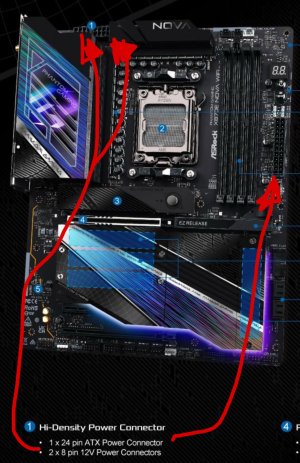I have an old EVGA Supernova 750 G2 PSU that I bought in 2016 or 2017 and that I've only used for a few months back then, and then I got a new computer with a new PSU.
I am now building a new system, with an AsRock 870E Nova motherboard.
I am thinking of extracting that old EVGA 750 G2 PSU and using it to power my new 870E motherboard.
Can you tell me if that will work?
Is there any reason why I shouldn't do that? Or will it be totally fine and no problems will come up as a result of using such an old PSU with a new motherboard?
I'm using a 2080 GPU.
Another question I have is: how will I know what are all the cables that I need to attach from my PSU to my motherboard, in order to make all of the functions of my motherboard work?
In the past, I would pay a technician to install the motherboard into the case, and install the CPU and heatsink and PSU.
This time I am going to try to do those things myself.
I've looked at my motherboard's online manual prior to making this post, but after doing that, I still feel very uncertain about knowing which cables I will need to plug in, and where, in order to make my new system work fully & properly. And also I don't know how to make sure that I won't have any cables plugged into the wrong the spot, or not plugged in at all even when they should be.
What can I do to make sure I get all of this straightened out? I'd rather not have to guess about how to do this, but I don't feel like I have enough knowledge to be confident that I can do it properly.
I am now building a new system, with an AsRock 870E Nova motherboard.
I am thinking of extracting that old EVGA 750 G2 PSU and using it to power my new 870E motherboard.
Can you tell me if that will work?
Is there any reason why I shouldn't do that? Or will it be totally fine and no problems will come up as a result of using such an old PSU with a new motherboard?
I'm using a 2080 GPU.
Another question I have is: how will I know what are all the cables that I need to attach from my PSU to my motherboard, in order to make all of the functions of my motherboard work?
In the past, I would pay a technician to install the motherboard into the case, and install the CPU and heatsink and PSU.
This time I am going to try to do those things myself.
I've looked at my motherboard's online manual prior to making this post, but after doing that, I still feel very uncertain about knowing which cables I will need to plug in, and where, in order to make my new system work fully & properly. And also I don't know how to make sure that I won't have any cables plugged into the wrong the spot, or not plugged in at all even when they should be.
What can I do to make sure I get all of this straightened out? I'd rather not have to guess about how to do this, but I don't feel like I have enough knowledge to be confident that I can do it properly.




